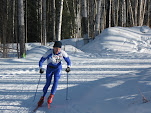Nordic ski racers now have a wide variety of events to choose from or to specialize in, with sprint racing (usually under 1.5 km), the standard classic (kick and glide) freestyle (skating) races (which range from 5 km local citizen races to 70+ km European marathon races). Recent additions include continuous pursuit races (usually ranging from 10 km to 30km), where racers ski classic for half the distance, and switch skis, poles, and techniques. It used to be a lot simpler. Through the 1984 Olympics, the standard distances were 15, 30, and 50 km for men, and 7.5, 15, and 30 for women, all a single technique.
Nordic skiing technique with the traditional kick and glide was relatively stable, if not staid, for more than 100 years through the 1960s, but the advent of trail grooming with machines plus lightweight modernized ski equipment (think Mrs. Robinson’s husband in The Graduate, encouraging Plastics!) set the stage for a revolution that rocked the 1980s.
Finnish great Pauli Siitonen is credited with the first shots of the skating revolution in the early and mid 1970s. His “Siitonen step” was simply a series of short skates that were employed around turns, as a means to accelerate in the transition between returning to the standard kick and glide.
According Bill Koch, who will go down in history as the eminent innovator of the skate revolution, speaking a clinic in Colorado years ago, sometime in the mid-late 1970s, Siitonen (or one of the top Scandinavian racers of the time) completely missed his kick wax on one of those tricky 30 – 34 F days, when it’s snowing, wet, and nothing works for the ski to grip long enough to generate power. “He stripped off his wax and just skated the whole course and won the race by three or four minutes, instead of a minute or two,” Koch recalled. “We just thought, Wow what an animal! But then we went back to the old way of skiing.”
By 1980 or 1981, throwing a few skates around turns or at the crest of a small hill was common practice for racers at all levels, but everyone used the traditional kick and glide technique throughout the races. But Koch, who had won the USA’s only Olympic medal ever, a surprise silver in 1976, was always looking for an advantage to get back on the podium at World Cup and championship races. In 1982 Koch had perfected the “marathon skate” where he would keep one ski in the tracked groove while propelling himself with his free ski. [photo] Koch won the overall World Cup title that year, a feat perhaps greater than his Olympic medal. He was even featured in a Sports Illustrated article by Kenny Moore, who described the marathon skate technique and reported on Koch’s sub-two hour 50k time trial, which was on a small loop on a pond in New England.
Although this first-ever feat did not capture the world’s imagination as did Bannister’s first sub 4 mile 28 years earlier, it was certainly noteworthy—considering that Koch averaged sub 4 for 31 consecutive miles! To put this in perspective, it would be like if a world class marathoner developed a new running technique and went out to a track and knocked 20 minutes off of the fastest times seen at Boston, London, or the Olympics.
Meanwhile, the traditionalists disapproved of skating, and some claimed that it didn’t even constitute real skiing, but the revolution was in motion. Next year Koch won a bronze for the 30k at the World Championships, which is the last time a US skier has medaled at that level. By the 1984 Olympics in Sarejevo, in the former Yugoslavia, skiers who wanted to be competitive were skating much if not most of the races. Rule makers implemented some restrictions, including a “no skate rule” over the first and last 200 meters of a race course. Ironically, the Norwegian Aunli was disqualified in those Games for skating at the finish of a race in which he had easily medaled. The Norwegians had been among the most ardent supporters of the traditional technique.
Through the 1984 Olympics, however, everyone skied with kick wax for the hill climbs, and they used skating for turns, flats and gentle slopes. But during the 1984 Polar Cup and 1984-85 World Cup season, the V1 skate (link to V1 technique) evolved and skiers began to race the entire distance on “waxless skis” (i.e., no kick wax), where the skis were waxed with parafin from tip to tail. The 1985 World Championships in Seefeld, Austria were highly controversial, with all the top finishers skating, leaving those using the traditional technique far back in the standings. At the time, talk ranged from banning skating from all races (European traditionalists), to leaving classic technique to the beginners and recreational skiers (Koch and skating revolution allies).
During the 1985 - 1986 season, it appeared that classic skiing was a technique of the past, as all the top racers skated. However, the International Ski Federation (FIS) convened and decided to bring back the traditional technique, and to have two separate types of skiing for Nordic racing: freestyle and classic. Some athletes protested, including Koch, who said that “classic skiing was being artificially propped up” by traditionalists. Nevertheless, for 20 years now, Nordic racing has enjoyed success and expansion as a multi-discipline sport, and no one seems worse off for it. In fact, if you work on both, you’ll become a better all-around skier than if you just do one.

0 Comments:
Post a Comment
Subscribe to Post Comments [Atom]
<< Home